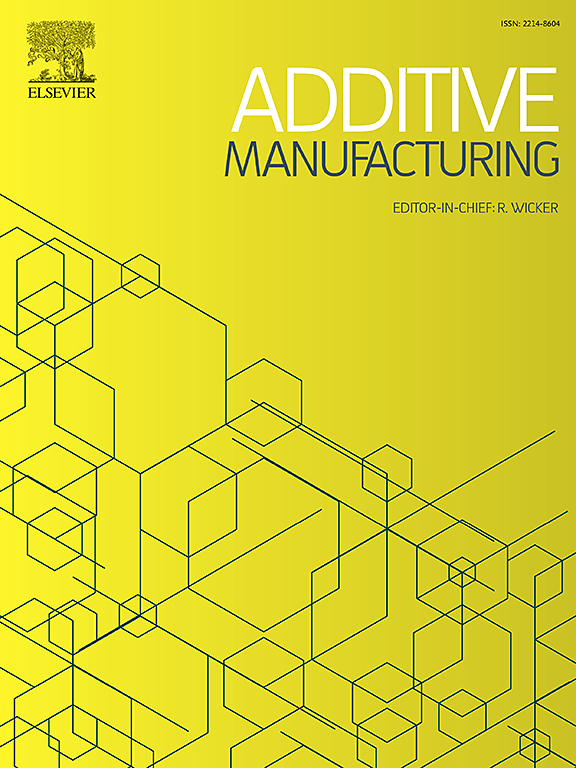Direct ink writing of magnetic soft materials with optimized printing path
IF 11.1
1区 工程技术
Q1 ENGINEERING, MANUFACTURING
引用次数: 0
Abstract
Direct ink writing (DIW) of magnetically responsive soft materials with high remanent magnetization, where a locally applied magnetic field aligns magnetized particles along the printing path, offers transformative potential across diverse applications. However, most existing studies have been confined to the printing of discrete magnetization patterns, which could restrict the functionality of achievable designs and preclude the creation of continuous magnetization distributions. Moreover, there is a lack of effective and automated path-generation methods capable of translating numerical designs with heterogeneous magnetization distributions and complex geometries into precise, manufacturable toolpaths. In this work, we introduce a novel, comprehensive framework that seamlessly integrates optimized design and additive manufacturing of hard-magnetic soft materials, enabling continuous magnetization encoding through the automatically generated printing paths. The framework extend the magneto-active soft material optimization approach to generate printable designs with continuous magnetization while considering manufacturing constraints. We propose an efficient toolpath generation algorithm that maps optimized magnetization directions to continuous printing paths, preserving the optimized topology. We explain the DIW process and experimentally characterize the mechanical and magnetic properties of the fabricated materials. The capabilities of the framework are comprehensively demonstrated through three experimentally validated examples: a magneto-active elevator mechanism, butterfly metasurfaces with complex magnetization distributions encoded by corresponding toolpaths, and a metamaterial design with globally generated toolpaths. These examples showcase the framework’s capability to effectively bridge the gap between design and additive manufacturing. The framework also has the potential for generalization across emerging 3D and 4D printing technologies involving other functional materials, opening new frontiers in the design and manufacturing of intelligent, responsive material systems.
磁性软质材料的直接墨水书写,优化打印路径
具有高剩余磁化强度的磁响应软材料的直接墨水书写(DIW),其中局部施加的磁场沿印刷路径对齐磁化颗粒,为各种应用提供了变革潜力。然而,大多数现有的研究都局限于离散磁化模式的印刷,这可能会限制可实现设计的功能,并排除连续磁化分布的创建。此外,缺乏有效和自动化的路径生成方法,能够将具有非均匀磁化分布和复杂几何形状的数值设计转化为精确的,可制造的刀具路径。在这项工作中,我们介绍了一种新颖的综合框架,该框架无缝集成了优化设计和硬磁软材料的增材制造,通过自动生成的打印路径实现连续磁化编码。该框架扩展了磁活性软材料优化方法,在考虑制造限制的同时,生成具有连续磁化的可打印设计。我们提出了一种有效的工具路径生成算法,该算法将优化的磁化方向映射到连续打印路径,并保留优化的拓扑结构。我们解释了DIW工艺,并通过实验表征了所制备材料的机械和磁性能。通过三个实验验证的实例,全面展示了该框架的功能:磁主动升降机构,具有相应刀具路径编码的复杂磁化分布的蝴蝶超表面,以及具有全局生成刀具路径的超材料设计。这些例子展示了该框架有效弥合设计和增材制造之间差距的能力。该框架还具有在涉及其他功能材料的新兴3D和4D打印技术中推广的潜力,为智能、响应性材料系统的设计和制造开辟了新的领域。
本文章由计算机程序翻译,如有差异,请以英文原文为准。
求助全文
约1分钟内获得全文
求助全文
来源期刊

Additive manufacturing
Materials Science-General Materials Science
CiteScore
19.80
自引率
12.70%
发文量
648
审稿时长
35 days
期刊介绍:
Additive Manufacturing stands as a peer-reviewed journal dedicated to delivering high-quality research papers and reviews in the field of additive manufacturing, serving both academia and industry leaders. The journal's objective is to recognize the innovative essence of additive manufacturing and its diverse applications, providing a comprehensive overview of current developments and future prospects.
The transformative potential of additive manufacturing technologies in product design and manufacturing is poised to disrupt traditional approaches. In response to this paradigm shift, a distinctive and comprehensive publication outlet was essential. Additive Manufacturing fulfills this need, offering a platform for engineers, materials scientists, and practitioners across academia and various industries to document and share innovations in these evolving technologies.
 求助内容:
求助内容: 应助结果提醒方式:
应助结果提醒方式:


